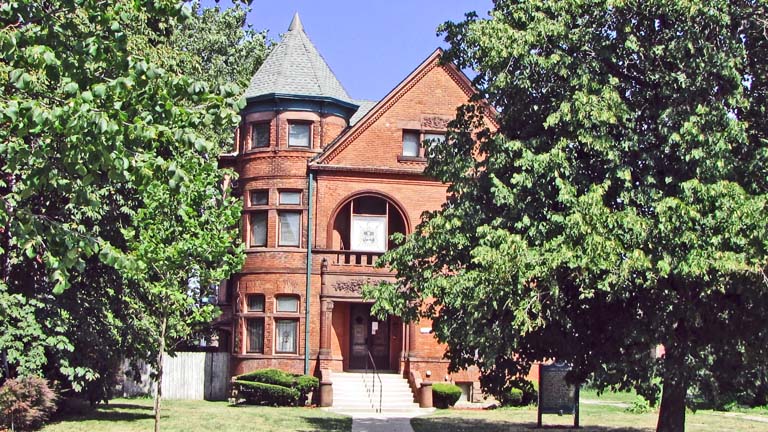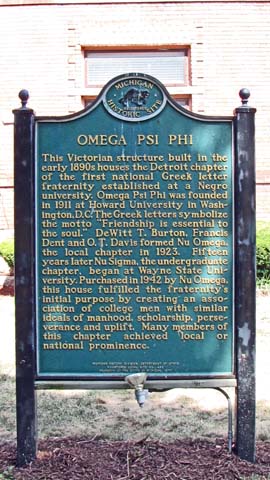
Omega Psi Phi Fraternity House
235 East Ferry Street in the East Ferry Historical District
This attractive house illustrates the architectural preferences
of prosperous Detroit residents in the last decade of  the 19th century.
This
three-story, brick-walled Tudor Style home is dominated by a turret capped
with an attractive and traditional spire at one corner. The heavy and dominating
arch on the second floor over the porch is Romanesque in style. Note the
elaborate and attractive stone work above the front porch on the first floor.
You will
also see that the architect devoted efforts to create transom windows on
the first floor, using attractive stonework. If you are interested in the
creative
and artistic use of brickwork and stonework, you could spend several weeks
studying the attractive buildings erected in Detroit from the last quarter
of the 19thcentury through the first quarter of the 20th. Are there many
architects in the 21st century who work as creatively with bricks and large
stone as
Detroit architects did in a fifty-year span centered on 1900?
the 19th century.
This
three-story, brick-walled Tudor Style home is dominated by a turret capped
with an attractive and traditional spire at one corner. The heavy and dominating
arch on the second floor over the porch is Romanesque in style. Note the
elaborate and attractive stone work above the front porch on the first floor.
You will
also see that the architect devoted efforts to create transom windows on
the first floor, using attractive stonework. If you are interested in the
creative
and artistic use of brickwork and stonework, you could spend several weeks
studying the attractive buildings erected in Detroit from the last quarter
of the 19thcentury through the first quarter of the 20th. Are there many
architects in the 21st century who work as creatively with bricks and large
stone as
Detroit architects did in a fifty-year span centered on 1900?
Omega Psi Phi was the first national Greek letter fraternity founded at an Historically Black university. It was established at Howard in 1911. The Detroit chapter, Nu Omega, was founded in 1923. In 1938, it became the undergraduate chapter for Wayne State. In 1942, the Nu Omega chapter purchased this home in what was to become the East Ferry Historic District.
Architect: Unknown to me.
Architectural style: Tudor Revival with evidence of Romanesque influences
and, perhaps, the influence of the brilliant architect of the late 19th century,
Henry Hobson Richardson.
Date of Completion: 1890
Michigan Registry of Historic Sites: P25190, Listed December 14, 1976
Michigan State Historic Marker: Erected September 23, 1977. This marker is
visible in front of the home on East Ferry.
Web site: http://www.oppf.org/
Use in 2003: Home of the fraternity
Photo: Ren Farley, November, 2002
Return to Racial History in Detroit
Return to Associations and Clubs